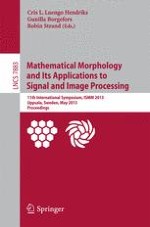2013 | Buch
Mathematical Morphology and Its Applications to Signal and Image Processing
11th International Symposium, ISMM 2013, Uppsala, Sweden, May 27-29, 2013. Proceedings
herausgegeben von: Cris L. Luengo Hendriks, Gunilla Borgefors, Robin Strand
Verlag: Springer Berlin Heidelberg
Buchreihe : Lecture Notes in Computer Science
